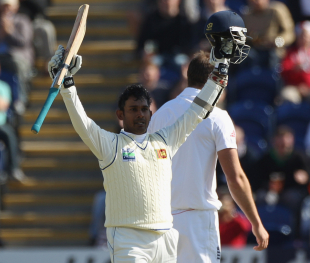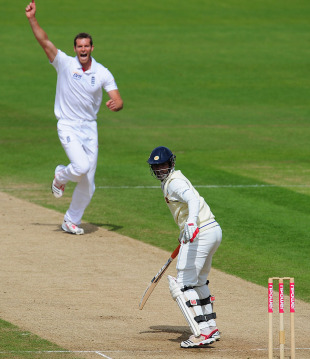England v Sri Lanka in England
Test matches (3): England 1, Sri Lanka 0
One-day internationals (5): England 3, Sri Lanka 2
Twenty20 international (1): England 0, Sri Lanka 1

|
|||
|
Related Links
Series/Tournaments:
Sri Lanka in England Test Series
|
|||
When Kumar Sangakkara - with six days of the tour still to run - delivered a coruscating critique of Sri Lanka's cricket administration in MCC's annual Cowdrey Lecture at Lord's, he appeared to validate the widely held suspicions about the game in his country. The immediate - and predictable - rebuke from sports minister Mahindananda Aluthgamage simply underlined Sangakkara's claims of political interference. But if Aluthgamage's outburst felt poignantly ironic, then the shambolic nature of the Sri Lankan board was reflected by a touring party that was ill-prepared and ill-equipped for their seventh Test trip to England and their first series outside Asia since 2008. Defeat in a disappointingly damp Test series was no great shock, even if the outcome was decided by just two hours of supine Sri Lankan batting in Cardiff. But their loss in the one-day series, having led with two to play, was more surprising, and contrasted sharply with both the 5-0 scorching they had handed England on their previous visit, in 2006, and their status as World Cup runners-up.
There were moments to savour: Tillekeratne Dilshan's stirring 193 at Lord's, Sangakkara's match-saving hundred at Southampton's Rose Bowl - his first Test century in 18 attempts in the UK on probably his last full tour here - and the 21-year-old Dinesh Chandimal's century in the Lord's one-day inter- national. But any flash of individual excellence invariably had to compete for headlines with the politics. And of that there was plenty. Sangakkara, who had resigned the captaincy after the World Cup, shortly before arriving in England, needed his arm twisting to take the reins again when Dilshan fractured his right thumb and missed the Third Test. It was the job no one wanted, but almost everyone seemed to get, and two others temporarily took over: Thilan Samaraweera for the three-day game against Essex, and Thilina Kandamby for the Twenty20 match at Bristol.
Sri Lanka's cause was not helped by an inexperienced attack. None of their party had taken 100 Test wickets, while their seven specialist bowlers arrived with a total of 282; England's six Test wicket-takers in the series could boast 516. In fact, Sri Lanka's four most prolific bowlers of all time were absent from the Test tour, yet, frustratingly, still active in one arena or another. Muttiah Muralitharan (800 Test wickets) would play Twenty20 for Gloucester- shire; Chaminda Vaas (355) was giving Northamptonshire a head start in the County Championship's second division; Lasith Malinga (101) retired from Tests because of a persistent knee problem, but played in the one-dayers; and Sanath Jayasuriya (98), aged 41 and now a member of parliament, returned in controversial circumstances, granted a last hurrah by his political ally, President Mahinda Rajapakse, in the Twenty20 game and the first one-dayer. There was more political fallout during the one-day series when the government sacked the board's interim committee - a not uncommon occurrence - amid accusations of ticket-touting and outrage at the huge debt (around £9m) incurred after co-hosting the World Cup. All the while, the stench of pre-tour claims made by Hashan Tillekeratne, the former captain and now an opposition MP, that match-fixing had been widespread during his playing days, never quite went away - even if there was no fire to follow the smoke.
Jayasuriya's selection met with bewilderment and distress. The interim coach Stuart Law had no say in the decision, while younger players, fearing their careers would be stifled, were said to be in tears. There were echoes of the 2006 tour, when Jayasuriya was foisted upon the team for the final Test, at Trent Bridge. At least on that occasion he justified his selection for the one- day series that followed with centuries at The Oval and Headingley; this time he made eight and two, but was given a generous ovation by a full house at The Oval, even if Law's frosty body language as Jayasuriya returned to the dressing-room told its own tale. Law, meanwhile - the earthy, cheery Queenslander who had replaced his compatriot Trevor Bayliss after the World Cup - spent the tour in limbo, hoping in vain for confirmation from Colombo about his future. When this was not forthcoming he resigned after the Twenty20 victory at Bristol, though he had been contemplating his decision for weeks. Having been courted by Bangladesh, he was immediately appointed their head coach, while former Test seamer Rumesh Ratnayake was named Sri Lanka's interim coach for Australia's tour.
There were other off-field grievances too. The warm-up game at Uxbridge, the Lord's Test and the Oval one-day international were notable for protests outside the venues by Tamils over the alleged genocide committed by the Sri Lankan government, itself highlighted in a Channel 4 documentary aired before the Third Test. But despite the prime minister, David Cameron, calling for an investigation, and Foreign Office minister Alistair Burt's reference to "convincing evidence of violations of international humanitarian and human rights law", the British government gave no serious consideration to whether the tour should be interrupted or abandoned.
It came as little surprise that the cricket itself barely limped into life. Sri Lanka arrived in England without five players, including Sangakkara and Mahela Jayawardene, who were still involved in the Indian Premier League. And the impression that Test cricket was not uppermost in the players' minds seemed to be confirmed when a Singapore-based company, Somerset Entertainment Ventures, attempted to announce the launch of the Twenty20 Sri Lanka Premier League at Lord's during the Test series, with the major Lankan players in attendance. On a chaotic trip it seemed appropriate that the ECB vetoed the event almost immediately. Soon after, the SLPL itself was postponed for a year when India refused to release their players for the tournament.
Injuries played their part too. Sri Lanka's impressive victory, after following on, in the warm-up match against England Lions at Derby was undermined by knee-ligament damage to Nuwan Pradeep Fernando, the young fast bowler who looked set for a Test debut after taking four for 29, but was forced to fly home instead. It was a desperate blow to an attack already missing Angelo Mathews, the enterprising all-rounder who was injured at the end of the World Cup and would return only for the one- day games. Mathews had been Law's preferred choice as Test captain, but Dilshan was the administration' s favourite. In the end, Sri Lanka took only 30 England wickets in the three Tests, a pitiful return even allowing for continual interference from the weather, which deprived the series of 369 scheduled overs and rained on the supposed homecoming of England's Ashes heroes. The tourists lacked a new-ball spearhead or a wicket-taking spinner. The post-Murali era was prov- ing bleak and barren. For the most part, they toughed it out gamely, but they left their fighting spirit in the pavilion during an astonishing final session at Cardiff, where - with a draw looking all but certain - they were bowled out for 82 in 24.4 overs.

|
|||
That spared England, the better side over the series, from their first 0-0 scoreline in a home series of three Tests or more since Pakistan visited in 1974. It was also the first time since 1996 they had hosted successive draws in the same series, a sign of the changing times that demand aggression in the five- day game. It was that quality, embodied by Man of the Series Chris Tremlett, which underscored England's improbable Cardiff victory. However, there were times in the next Test, at Lord's, when they lacked urgency. England's one major selectorial decision provided a briefly compelling narrative. Paul Collingwood had retired from Tests after the Ashes and it came to be presumed that Ravi Bopara, who had shunned the IPL to hone his four-day form with Essex, would be recalled at the expense of Eoin Morgan (who did go to India). But in what amounted to a bat-off between the two in the Lions game, Morgan made 193 to Bopara's 17 and 29; so Morgan it was.
He justified his selection with two counter-attacking seventies, but was overshadowed by the relentless Alastair Cook, who maintained his Ashes form with two hundreds and two fifties in four innings. Commentating on Test Match Special, Christopher Martin-Jenkins wondered whether bowling to Cook at his best was akin to facing Kent's pre-war colossus, Frank Woolley. Ian Bell was sublime, scoring 331 runs for once out, while Jonathan Trott's 203 in the First Test set the tone for a summer of English batting gluttony. But their bowling was less consistent: despite catching Sri Lanka cold in the second innings at Cardiff without James Anderson, who collected back and side niggles in the first, they struggled both earlier in that match and on an unyielding track at Lord's. Tremlett was unplayable at times on a bouncy Rose Bowl pitch, but Stuart Broad, fulfilling his questionable "enforcer" label, huffed and puffed with growing frustration and petulance, and was dropped for the final one-dayer.
As if to conform to the subcontinental stereotype, there was a direct correlation between weather conditions and Sri Lanka's performance. By and large, they struggled in the damp and gloom, and prospered in the sun, with the one deviation the fifth and deciding one-day game, at Old Trafford. England's victory, there, in the only close match of the series, was the result that defined Cook's first major trial as England's 50-over captain. Light- heartedly branded a "plodder" and a "donkey" by Mike Atherton on Sky Sports ahead of the series, he finished it as the leading run-scorer on either side with 298 runs, an average of 74 and a strike-rate of 96.
By contrast, the form of his opposite number Dilshan, so brave and bullish in the Lord's Test, collapsed after his return from injury: 17 runs in five one- day innings was a wretched return for one of the game's greatest limited-overs innovators. Absent from the one-day series was Upul Tharanga, the opening batsman who, like Dilshan, made an unbeaten hundred against England in the World Cup quarter-final, but was temporarily banned after failing a drugs test - supposedly a herbal remedy for a shoulder injury - taken during the tournament.
If Sri Lanka's insipidity with the ball had been predictable, the paltry contributions from Sangakkara and Jayawardene (who managed 287 runs between them in the Tests) were a disappointment for their team and spectators alike. Jayawardene did produce a brilliantly paced 144 in the Headingley one- dayer, but his slip-catching was untypically shoddy. Sangakkara, who had a poor record in England anyway, redeemed himself at the Rose Bowl, but he undoubtedly saved his best performance for an early July evening in the Nursery Pavilion at Lord's.
Match reports for
1st Test: England v Sri Lanka at Cardiff, May 26-30, 2011
Report |
Scorecard
2nd Test: England v Sri Lanka at Lord's, Jun 3-7, 2011
Report |
Scorecard
3rd Test: England v Sri Lanka at Southampton, Jun 16-20, 2011
Report |
Scorecard

